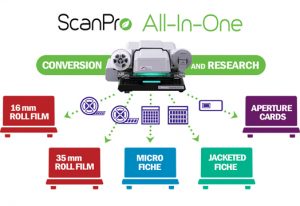 Many public and private organizations are on the path of preserving vital records by using modern microfilm scanners. These scanners produce high quality scans and improve document retrieval efficiencies. However, others continue using microfilm on a daily basis as the preferred format. Regardless of what camp your organization favors, eBizDocs has the solution. We offer specialty scanners designed to read microfilm and/or convert these images into a digital format. Plus… If converting at your facility is too much trouble, we can do it for you in our secure SOC2 environment.
Many public and private organizations are on the path of preserving vital records by using modern microfilm scanners. These scanners produce high quality scans and improve document retrieval efficiencies. However, others continue using microfilm on a daily basis as the preferred format. Regardless of what camp your organization favors, eBizDocs has the solution. We offer specialty scanners designed to read microfilm and/or convert these images into a digital format. Plus… If converting at your facility is too much trouble, we can do it for you in our secure SOC2 environment.
While microfilm has its limitations, compared to the modern capabilities of digital documents, its obsolescence is still years away. Following the erroneous publication of his obituary in 1897, Mark Twain cabled a message from London to the United States reading, “The reports of my death are greatly exaggerated.” Though no literal obituary has been published, the death of microfilm has been declared for decades now. And we’re here to tell you, its death is also greatly exaggerated.
Computers ushered in the digital age, and though they began with humble storage volume, that capacity grew and grew. Then, the storage mechanisms got so small they could be portable. “Forget paper records,” they said. “Store them on a computer.” Then, you could store documents on a floppy disk. Then, on a mini-disk. Then, on a compact disc (CD). Then on a flash drive. Then in the “cloud.” As you can see, in the course of only a few decades, the storage media of the future quickly became the obsolete storage media of the past. All the while, millions upon billions of old records and documents remained securely captured in microforms.
The progression of digital media is again threatening to write the obituary of microfilm, and while progress is indeed being made to integrate microfilm and digital recordkeeping, it’s probably safe to assume the death of microfilm is still greatly exaggerated.
Advantages and Disadvantages of microfilm
Advantages
- Life expectancy – if done properly with good materials – theoretically 500+ years
- Small footprint – You can store large archives in 1 normal sized room
- Difficult to counterfeit
- Theft proof – Microfilm requires some time and effort to read. Theft of information takes a bit longer, hence you have more time before all your information is stolen
- Inexpensive, when you consider how much information you are storing
- Benefits from a legal standpoint, accepted as an official storage medium
Disadvantages
- Life expectancy – Unproven. Microfilm has been in use for around 80 years. Cellulose acetate base is prone to tears, vinegar syndrome, and redox blemishes.
- Difficult to read on a fly. This is why microfilm is complementary to digital archiving, Digital for immediate retrieval, microfilm for permanent storage.
- It takes more space than digital. While you can store 2500 documents on a roll of microfilm, it is still less than what you can store a similar sized HDD.
- Less and less professionals in the industry – It’s an ageing industry and most of the people left are highly skilled. As people retire, fewer and fewer are filling the void.
Fortunately, options exist that can provide the best of both worlds, such as the e-ImageData ScanPro® All-In-One™, which has the ability to scan and read microfilm, as well as print and convert documents. To better understand how an All-in-One can solve your digitization dilemma, contact the experts at eBizDocs and we’ll be glad to discuss your needs.

About eBizDocs – eBizDocs is a premier digital transformation provider focused on helping you put INFORMATION AT YOUR FINGERTIPS. Offerings include paper and microfilm conversion, content capture and document management solutions, scanner sales and service, and process consultation. eBizDocs is SOC2 Type II certified and serves private and public-sector organizations. The company has been in business for over 20 years and is a preferred source contractor for NYS entities. To learn how eBizDocs can help transform your operation, visit eBizDocs.com

